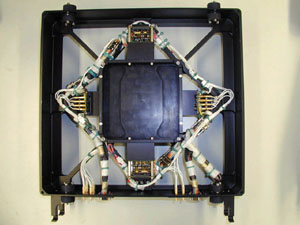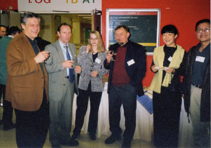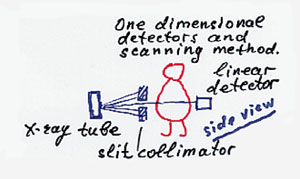The big topic of debate at the 9th Vienna Conference on Instrumentation held in February was whether gaseous detectors can still compete with semiconductor technology. This conference series offered the perfect forum to discuss the latest developments.

Whether to bank on techniques with gaseous detectors or to go for alternative modern
semiconductor technology is a continual dilemma in experiment design. To enable delegates to draw their own conclusions, a new approach was adopted for the invited talks at the recent Vienna Conference on Instrumentation.
In the past, the invited talks have concentrated mainly on classes of detectors (e.g. calorimeters), but this time they also included overviews of detector systems dictated by the type of accelerator to be used; e.g. B-factories (D R Marlow, Princeton) and triggering at LHC experiments (W H Smith, Wisconsin).
Gaseous detectors still strong
The first Vienna conference, held in 1978, concentrated exclusively on gaseous detectors. However, as gaseous detectors began to be used as parts of complex subdetectors, such as calorimeters or ring imaging Cherenkovs, or for functions such as rate of energy loss, the remit of the conference was extended to include wire chambers and alternative techniques.
With the advent of silicon detectors, the conference began to focus more and more on general instrumentation. Contributions to the first conference had been almost exclusively on high-energy physics (with a few exceptions on medical applications). Now, however, the scope of the conference has grown to incorporate nuclear physics, synchrotron radiation and neutron experiments, astrophysics, biology, medicine and associated electronics. This change was reflected in the renaming of the conference, to the Vienna Conference on Instrumentation.
However, gaseous detectors are still very actively discussed at the conference, with the majority of new developments presented this year dealing with micropattern detectors. The first session on micropattern gas detectors opened with an invited talk by R Bellazini (Pisa) who gave a comprehensive overview of the various structures. The ingenuity of this community is amazing, with an overall trend towards the de-coupling of amplification and readout, e.g. the gas electron multiplier (GEM) plus the microstrip gas chamber, or the GEM plus the microgroove. The most exciting prospect for future developments could be pixel readout structures for these kind of devices.

Several of the conference talks and posters showed results from multi-stage detectors, with two or more amplification layers being suggested as a possible way to achieve a high gas gain with a low discharge probability (low spark rate). J Va’vra (SLAC) clearly
held the record at this year’s conference, with results on single electron detection with a quadruple GEM detector.
The Micromegas detector was the subject of the invited talk by G Charpak. This attractively simple detector is already used for several applications, for example in the COMPASS experiment at CERN. The Micromegas detector developed for this experiment (A Magnon, Saclay) has an active area of 0.4 x 0.4 m2 and achieved a position resolution of 75 µm in a high-intensity beam with negligible spark rate.
Silicon detectors have their day
A full day was devoted to silicon detectors, beginning with an overview by H Dijkstra (CERN). The talks that followed presented prototype work for strip detectors for LHCb (P Collins, CERN) and for drift detectors for ALICE (E Crescio, Torino). The news from L Casagranda (CERN) that silicon detectors cooled to cryogenic temperatures can withstand fluxes of more than 5 x 1014 ions/cm2 and still deliver sufficiently high signals was particularly exciting. And Y Gornushkin (Strasbourg) presented a brand new development on monolithic active pixel sensors.
Naturally, the two large multipurpose CERN LHC experiments, ATLAS and CMS, which are beginning production of their very large silicon trackers, were well represented. P Riedler (Zürich) described the application of very thin silicon detectors, just 5-70 µm thick, used in the ATHENA low-energy antiproton experiment as a beam counter.
On 24 February, a satellite workshop concentrated mainly on applications in radiology and monitor systems for teletherapy in radiooncology with protons and heavier nuclei, which is of increasing interest in view of the Med-AUSTRON project.

A truly intercontinental coffee break: the regional spread of attendance at the Vienna conference has greatly increased.Judging by the latest developments as presented at Vienna, the answer to the question of whether gas detectors can compete with silicon is probably that both gas and silicon detectors are required to build an up-to-date high-energy physics experiment. However, it is clear that there are two areas in large experiments where each technology is superior to the other. Firstly, semiconductor detectors perform better very close to the interaction region, where a precision of a few micrometers is required and the radiation is extremely high. But at large radius where large areas have to be covered, e.g. the muon chambers, it is unrealistic to use anything other than gas detectors.
It is in the intermediate region between about 20 cm and 2 m radius where the two technologies meet as rivals. From the presentations given in Vienna it became clear that silicon and micropattern gas detectors fulfil all the necessary requirements concerning precision, rate capability and radiation hardness. And, from the many comments made, it seemed that participants were split into two factions: the cautious, who don’t accept a single spark over the detector’s lifetime – an attitude which drives them towards spending their money on silicon; and the bold, trying to convince the audience that a very small spark rate in a gas detector is fully acceptable for a large system.
For the LHC experiments now under construction, this debate is over, but it will be interesting to see how further developments will influence the detector layout of future experiments.
A brief history of the Vienna series
The Vienna Wire Chamber Conference series was first mooted in 1977 when it was realized that there was a real need for such a conference. (There was only one detector conference in 1977, in Novosibirsk, Russia, but none in Europe.) A total of 170 people took up our first invitation to Vienna, and nobody thought that 23 years later we would be fixing the date for the 10th Vienna Conference for February 2004.

The number of participants rose to a maximum of 300 at subsequent meetings, although in February 2001 this dipped to 250. The main reasons for this were that support from the European Union has become more restrictive, and several participants cancelled when their contributions were not accepted. In addition, there are now several competitive conferences each year, and US researchers have travel budget restrictions. Despite this, the regional spread of attendance was wider this year, in terms of region as well as nation of origin. Russia, for example, had a strong delegation from St Petersburg.
The selection process
It is a strict rule at the Vienna Conference that all contributions (talks and posters) have to be accepted by the International Scientific Advisory Board. All material was sent to the members of this committee three months before this year’s conference; six weeks later, a meeting was held at CERN to make the selection. Members who cannot attend this part of the process can give their judgment by mail, and all efforts are made to discuss by telephone before the final decision is made.

Applications for financial support (e.g. from the Exchange Programme of the Austrian Academy of Sciences, the European Physical Society, or the Austrian Ministry of Education, Science and Culture, with support from the organizers) are totally independent of acceptance for publication.
Transparencies of the talks were scanned and made available immediately at http://wcc.oeaw.ac.at/. The draft papers of all talks and posters will also be put on the Web until the final proceedings – a consecutively numbered volume of Nuclear Instrumentation and Methods, as usual – become available in the late autumn.
The memorable concert by a string quartet in the Great Hall of the Austrian Academy of Sciences was dedicated to the history of music in the hall, and a CD of the concert, mastered overnight, was given as a souvenir to all participants. The organizers (M Jeitler, M Krammer, G Neuhofer, M Regler) are very much looking forward to the 10th Vienna Conference in February 2004.





